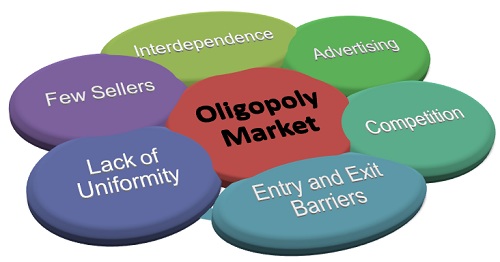Economics Fundamentals: Understanding Oligopolies
Oligopoly is the most interesting of all market structures. Being an intermediate market structure between perfect competition and monopoly, oligopoly is an industry where few mutually interdependent firms producing homogenous (homogeneous oligopoly) or differentiated products (differentiated oligopoly) operate and control their prices based on the level of coordination among them. The number of firms, although it is not explicitly required, typically ranges between two (duopoly) and ten. From a managerial point of view, a firm operating in an oligopoly is the most difficult to manage. Given that there are few firms in an oligopolistic market managers must consider the likely impact of a managerial decision on the decisions of other firms of the industry. Besides, the actions of the other firms are likely to have a major impact on optimal managerial decision-making.
To better understand oligopoly interdependence, consider a situation where several firms that compete in an oligopoly sell differentiated products. To determine what price to charge, managers should take into consideration the impact of their decision-making on the other firms of the industry. For example, if the price of a product is lowered, will other firms in the industry lower their prices as well or will they maintain their current prices? Optimal decision-making of whether to lower or raise the prices will depend on how the manager believes other managers will respond. If other firms in the industry lower their prices as a response to the firm’s price decrease, it will not sell as much as it would if the other firms maintained their existing prices.
Oligopolies typically emerge as a result of internal or external economies of scale. Internal economies of scale are created in firms from the division of labor of fixed or working capital over a certain range of output. Large firms that tend to profit from economies of scale create the emergence of oligopolies or to its extreme form, monopolies, to dominate the market. External economies of scale are created when an industry takes advantage from the technological experiences or facilities of its firms (technological economies) or when industry-wide savings occur in the expenditure required to create demand (financial economies).
One of the basic characteristics of oligopolistic structures is that there are barriers to entry, which may be structural such as economies of scale or artificial as a result of governmental intervention. Firms that operate in oligopolies determine their prices and output to achieve profit maximization. However, they may also compete in advertising, research and development (R D;), location (first-mover advantage) and in other dimensions as well. For example, a firm’s advertising strategies are influenced by the decision-making of the rival firms.
The response of rival firms in an oligopoly structure is modeled by the reaction function. Because oligopoly as a market structure is quite complex, there is no single model that is applicable for all oligopolies. Mutually interdependent firms tend to form cartels that enable them to control price and quantity output and increase their profitability. However, the majority of oligopoly models are based on different behavior ranging from simplistic Cournot model to more sophisticated models of game theory. The most commonly known equilibrium concept incorporating mutual interdependence is the Nash equilibrium that suggests that a firm’s pricing and output decisions are its best responses, given the strategies of the rival firms. For instance, in the airline industry, which is a typical example of oligopoly, firm A charges $200.00 for a ticket to a specific destination based on what firm B and firm C are charging for the same destination. If rival firms change their prices, firm A would reconsider its pricing.
The performance of an oligopoly is also difficult to measure. Generally, the oligopoly price is higher the competitive price but its output falls shorter than the competitive market. Also, in relation to monopoly, oligopoly output is larger than that of the monopoly but its price is lower than the monopoly price. There are competitive oligopoly markets and monopolistic oligopoly markets, while there are also innovative oligopoly markets. Generally, it all depends on the level of information that the firms in an oligopoly have and on the impact of R D; and advertising on the price and output decision-making in an oligopoly structure.
















